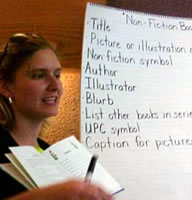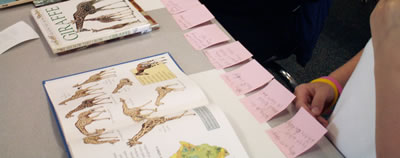 Inquiry 3: Animal Inquiry
Inquiry 3: Animal Inquiry
Click the comic link or comic image on the right to view the graphic version of Animal Inquiry inquiry. Read the narrative below.
Animal inquiries are fun and effective throughout the primary grades. From ocean life to rainforest dwellers, children enjoy exploring the natural world.
Encouraging Inquiry
Young people are encouraged to wonder, ask questions, and explore the world around them. Kindergarten and first graders can easily brainstorm topics, search words, and information tools. These young inquirers come up with wonderful questions about animals. They can categorize information, takes notes, and organize their ideas.


 Providing Mini-Lessons
Providing Mini-Lessons
Mini-lessons are used to enhance information skills at each grade level. The media specialist and classroom teacher collaborate to address both information and content-area standards.
As young people mature, their skills are refined. For instance, kindergarteners are able to identify the title and author of a book, while third graders create citations that include more in-depth information.
Addressing Individual Needs
Worksheets, flipchart paper, folders, sticky notes, and other tools are used to guide young people through the inquiry process. Scaffolding is provided to help children prepare for inquiry, organize and synthesize their ideas, and create communications. To meet individual needs, a variety of resources and tools are used. While some students are more comfortable with text, others enjoy expressing themselves visually.

 Creating Communications
Creating Communications
Young people are encouraged to share their understandings through the creation of meaningful products.
Posters, letters, brochures, web pages, photographs, and videos are just a few of the ways young people can communicate their ideas to an audience.
Inquiry activities in the primary grades lay the foundation for life-long learning. The key is providing an environment that encourages questioning, provides just-in-time assistance, and addresses individual differences.
